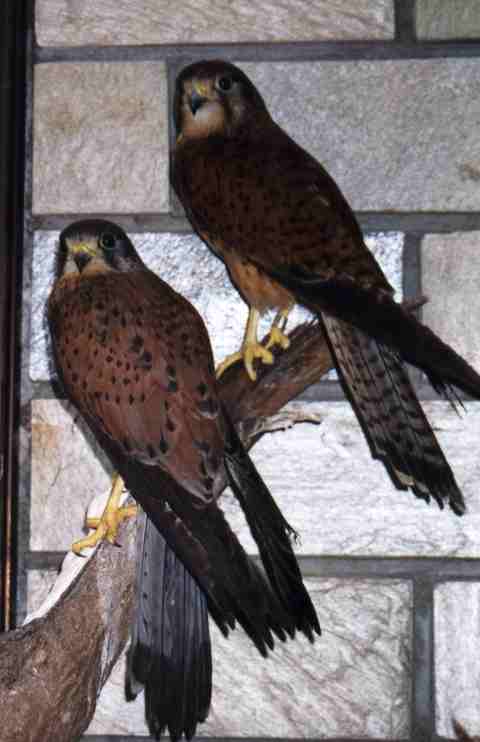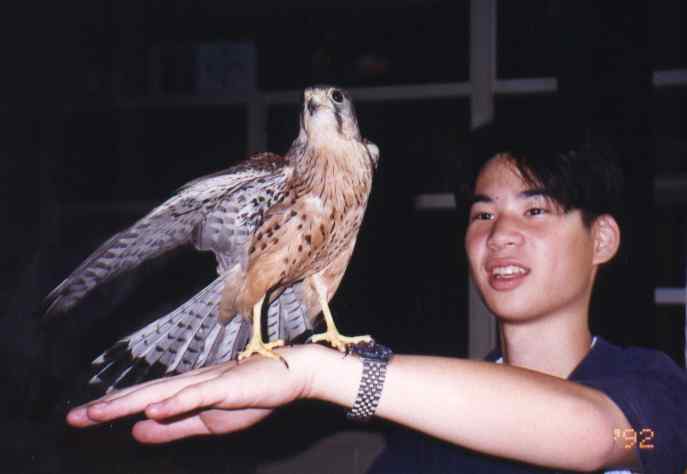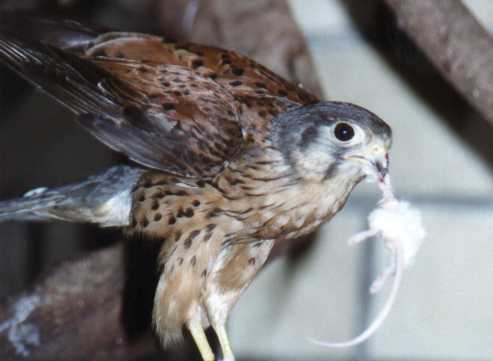F.B.MAGPIE HOME PAGE
My Common Kestrels
 I've
adopted these two Common Kestrels for the Wild Bird Society of Taipei.
I got the male bird (with the gray head) in April, 1997. He suffered a
broken wing that did not heal properly, so he would have lived the rest
of his life in captivity. The female bird arrived in November, 1997 and
was planned to be released as soon as her tail and flight feathers regrow.
The two birds lived together on my balcony despite frequent quarrels between
them. The female was larger than the male and would often steal food from
the male. They also fought over their favorite branch quite often.
I've
adopted these two Common Kestrels for the Wild Bird Society of Taipei.
I got the male bird (with the gray head) in April, 1997. He suffered a
broken wing that did not heal properly, so he would have lived the rest
of his life in captivity. The female bird arrived in November, 1997 and
was planned to be released as soon as her tail and flight feathers regrow.
The two birds lived together on my balcony despite frequent quarrels between
them. The female was larger than the male and would often steal food from
the male. They also fought over their favorite branch quite often.  I
fed the Kestrels pounded chicken neck as a staple and white mice occasionally.
Unfortunately, while I was off to Cornell summer college in 1998, both
kestrels escaped through the window screen of the Wild Bird Society volunteer
who was taking care of them over the summer. The search for the missing
kestrels was unsuccessful. While, according to the volunteer, there was
some habitat nearby where the birds might take refuge, it is unclear whether
they would be able to feed and fend for themselves in their physical conditions.
The male could not fly for long distances and was beginning to lose weight
drastically. The female's tail had become fully grown but her flight feathers
were still short. Hopefully, she will recover on her own and be able to
migrate to her breeding grounds.
I
fed the Kestrels pounded chicken neck as a staple and white mice occasionally.
Unfortunately, while I was off to Cornell summer college in 1998, both
kestrels escaped through the window screen of the Wild Bird Society volunteer
who was taking care of them over the summer. The search for the missing
kestrels was unsuccessful. While, according to the volunteer, there was
some habitat nearby where the birds might take refuge, it is unclear whether
they would be able to feed and fend for themselves in their physical conditions.
The male could not fly for long distances and was beginning to lose weight
drastically. The female's tail had become fully grown but her flight feathers
were still short. Hopefully, she will recover on her own and be able to
migrate to her breeding grounds.
 Common
Name: Common Kestrel
Common
Name: Common Kestrel
Scientific Name: Falco tinnunculus
Length: 30 cm (male), 33 cm (female); wingspan 69~74 cm
Distribution: widespread throughout Asia and Europe
The Common Kestrel is a common winter migrant of Taiwan. It can easily
be seen on open plains, marshes, and cultivated lands; they can even be
seen occasionally on the TAS campus. Kestrels often hovers over open fields
scanning the ground below for prey, which include insects, rodents, and
small birds.
[ Trip
Reports | Photo Gallery | Art
Gallery | Bird Calls | Birds
of TAS | Links | Webrings
| Guestbook
| ICQ ]


 I've
adopted these two Common Kestrels for the Wild Bird Society of Taipei.
I got the male bird (with the gray head) in April, 1997. He suffered a
broken wing that did not heal properly, so he would have lived the rest
of his life in captivity. The female bird arrived in November, 1997 and
was planned to be released as soon as her tail and flight feathers regrow.
The two birds lived together on my balcony despite frequent quarrels between
them. The female was larger than the male and would often steal food from
the male. They also fought over their favorite branch quite often.
I've
adopted these two Common Kestrels for the Wild Bird Society of Taipei.
I got the male bird (with the gray head) in April, 1997. He suffered a
broken wing that did not heal properly, so he would have lived the rest
of his life in captivity. The female bird arrived in November, 1997 and
was planned to be released as soon as her tail and flight feathers regrow.
The two birds lived together on my balcony despite frequent quarrels between
them. The female was larger than the male and would often steal food from
the male. They also fought over their favorite branch quite often.  I
fed the Kestrels pounded chicken neck as a staple and white mice occasionally.
Unfortunately, while I was off to Cornell summer college in 1998, both
kestrels escaped through the window screen of the Wild Bird Society volunteer
who was taking care of them over the summer. The search for the missing
kestrels was unsuccessful. While, according to the volunteer, there was
some habitat nearby where the birds might take refuge, it is unclear whether
they would be able to feed and fend for themselves in their physical conditions.
The male could not fly for long distances and was beginning to lose weight
drastically. The female's tail had become fully grown but her flight feathers
were still short. Hopefully, she will recover on her own and be able to
migrate to her breeding grounds.
I
fed the Kestrels pounded chicken neck as a staple and white mice occasionally.
Unfortunately, while I was off to Cornell summer college in 1998, both
kestrels escaped through the window screen of the Wild Bird Society volunteer
who was taking care of them over the summer. The search for the missing
kestrels was unsuccessful. While, according to the volunteer, there was
some habitat nearby where the birds might take refuge, it is unclear whether
they would be able to feed and fend for themselves in their physical conditions.
The male could not fly for long distances and was beginning to lose weight
drastically. The female's tail had become fully grown but her flight feathers
were still short. Hopefully, she will recover on her own and be able to
migrate to her breeding grounds.
 Common
Name: Common Kestrel
Common
Name: Common Kestrel